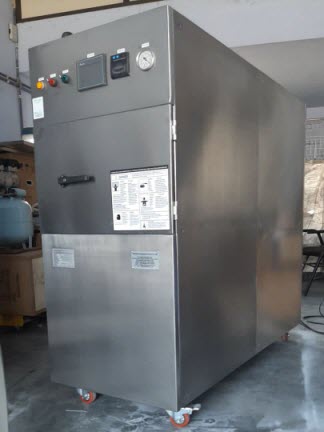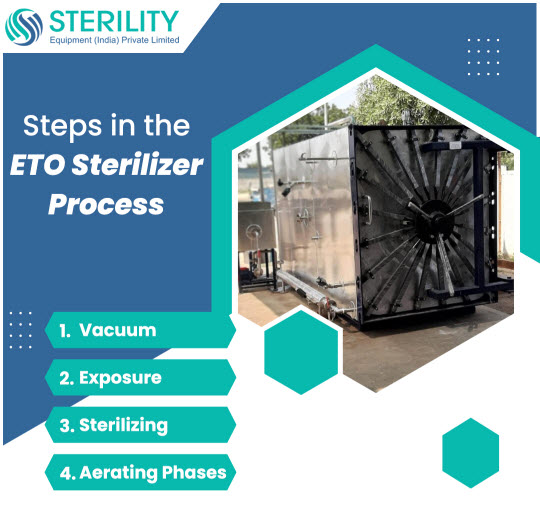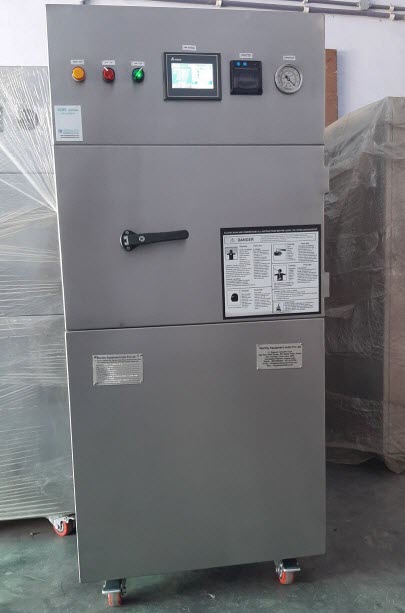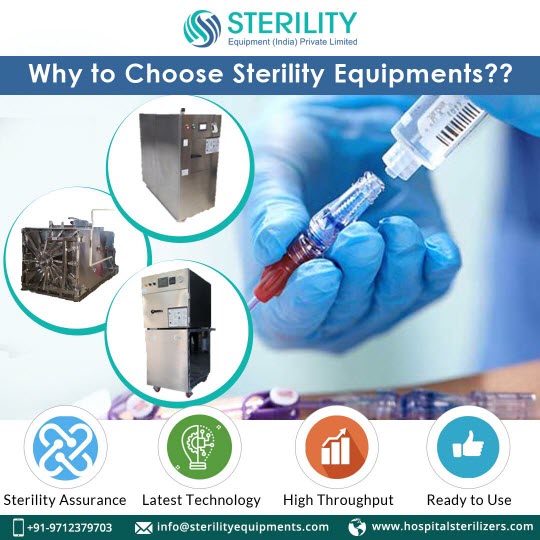1. Introduction to ETO Sterilization Validation
ETO (ethylene oxide) sterilization validation plays a crucial role in ensuring the safety and sterility of medical devices and equipment in the healthcare industry. By validating the effectiveness of ETO sterilization, healthcare facilities can confidently rely on this method to eliminate harmful microorganisms. In this article, we will provide an overview of ETO sterilization validation, discussing its significance, key parameters, and challenges.
The Significance of ETO Sterilization Validation in Healthcare
The healthcare industry heavily relies on ETO sterilization to ensure the sterility of critical medical devices and equipment. Validation is an essential step in this process, as it confirms the effectiveness of ETO sterilization in eliminating microorganisms, including bacteria, viruses, and spores. By validating the sterilization process, healthcare facilities can uphold the highest standards of patient safety and infection control.
Key Parameters in ETO Sterilization Validation
Validating the effectiveness of ETO sterilization involves considering several key parameters. These parameters include exposure time, temperature, gas concentration, and humidity. Each parameter plays a vital role in achieving the desired level of sterilization. By meticulously controlling and monitoring these parameters, healthcare facilities can ensure the reliable and consistent sterilization of medical devices.
Challenges in ETO Sterilization Validation
ETO sterilization validation comes with its own set of challenges. One significant challenge is the presence of residuals, which refers to the ethylene oxide remaining on sterilized products after the process. Residuals must be minimized or eliminated to prevent any potential harm to patients or healthcare workers. Additionally, ensuring product compatibility with ETO sterilization and addressing safety concerns are crucial challenges that need to be addressed during validation.
Ensuring Regulatory Compliance in ETO Sterilization Validation
Regulatory compliance is a critical aspect of ETO sterilization validation. Healthcare facilities must adhere to established regulations and guidelines to maintain patient safety and meet industry standards. Compliance involves following proper validation protocols, documenting processes accurately, and implementing a comprehensive quality management system. By meeting regulatory requirements, healthcare facilities can demonstrate their commitment to delivering safe and sterile medical devices.
Future Trends in ETO Sterilization Validation
As technology advances, the field of ETO sterilization validation continues to evolve. Emerging trends focus on enhancing the efficiency and effectiveness of the validation process. For example, the integration of automation and real-time monitoring can streamline validation procedures and provide immediate feedback on the sterilization process. Additionally, innovations in sterilization advancements and process optimization are continuously being explored to improve the overall efficacy and safety of ETO sterilization.
ETO sterilization validation plays a vital role in ensuring the safety and sterility of medical devices in the healthcare industry. By understanding the significance, key parameters, and challenges involved in ETO sterilization validation, healthcare facilities can implement effective processes and meet regulatory compliance. Embracing future trends and innovations further enhances the reliability and efficiency of ETO sterilization validation, leading to improved patient care and infection control.

2. Understanding ETO Sterilization Process
ETO (ethylene oxide) sterilization is a widely used method for achieving effective sterilization of medical devices. In this section, we will delve into the ETO sterilization process, providing a comprehensive understanding of how it works and the crucial factors that impact its efficacy.
The Sterilization Chamber
The ETO sterilization process involves the use of a sterilization chamber, where medical devices and equipment are placed for sterilization. The chamber is designed to create an environment conducive to the effective elimination of microorganisms. It is sealed to prevent the escape of ethylene oxide gas and to maintain the necessary conditions for sterilization.
Gas Diffusion
Once the medical devices are placed inside the sterilization chamber, ethylene oxide gas is introduced. Gas diffusion is a critical aspect of the process, as it allows the ethylene oxide to permeate and penetrate the materials, reaching all surfaces and crevices of the devices. Proper gas diffusion ensures thorough sterilization and eliminates the risk of any remaining pathogens.
Temperature Control
Temperature control is another essential factor in the ETO sterilization process. Maintaining the correct temperature ensures optimal conditions for sterilization. Typically, temperatures between 37-63°C (99-145°F) are maintained throughout the process. This range is carefully selected to ensure effective microbial inactivation while minimizing any potential damage to the medical devices.
Humidity Control
Humidity control is also crucial during ETO sterilization. Adequate humidity levels promote the penetration and diffusion of ethylene oxide gas. Proper moisture content in the sterilization chamber helps create an environment conducive to the sterilization process. The optimal humidity range for ETO sterilization is typically between 40-80% relative humidity.
Monitoring and Validation
Throughout the ETO sterilization process, continuous monitoring and validation are necessary to ensure its effectiveness. Monitoring devices are used to measure and control the parameters such as temperature, humidity, and gas concentration. Regular validation processes, including biological indicator testing, are performed to verify the efficacy of the sterilization process and ensure consistent results.
Understanding the ETO sterilization process is crucial for ensuring effective sterilization of medical devices. The sterilization chamber, gas diffusion, temperature control, and humidity control are key factors that impact the efficacy of ETO sterilization. By maintaining proper conditions and conducting regular monitoring and validation, healthcare facilities can rely on ETO sterilization to achieve reliable and safe sterilization of medical devices.

3. Key Parameters for ETO Sterilization Validation
ETO (ethylene oxide) sterilization validation requires careful consideration of various key parameters to ensure the effectiveness and reliability of the sterilization process. In this section, we will outline the essential parameters that should be evaluated during ETO sterilization validation.
Process Parameters
Process parameters play a crucial role in determining the success of ETO sterilization. These parameters include exposure time, gas concentration, and aeration time. Exposure time refers to the duration for which medical devices are exposed to ethylene oxide gas. It is important to establish an appropriate exposure time to ensure sufficient microbial inactivation while avoiding potential damage to the devices. Gas concentration refers to the level of ethylene oxide present in the sterilization chamber. Maintaining the correct gas concentration is essential for achieving effective sterilization. Aeration time refers to the period during which ethylene oxide gas is removed from the sterilized devices, ensuring the elimination of any residual gas and making the devices safe for use.
Evaluation of Bioburden Levels
Bioburden refers to the microbial contamination present on the medical devices before sterilization. Evaluating bioburden levels is a critical step in ETO sterilization validation. By assessing the initial bioburden, healthcare facilities can establish baseline contamination levels and determine the appropriate sterilization parameters required to achieve desired sterility assurance. Bioburden testing can be performed using methods such as microbial enumeration or ATP (adenosine triphosphate) bioluminescence testing.
Microbial Challenge Testing
Microbial challenge testing involves intentionally introducing a known number of microorganisms onto test devices to evaluate the sterilization process’s effectiveness. This testing validates the capability of the ETO sterilization process to eliminate a specified level of microbial contamination. By subjecting the devices to a controlled microbial challenge, healthcare facilities can ensure that the sterilization process consistently achieves the desired level of microbial reduction or inactivation.
Importance of Validation Protocols
Following well-defined validation protocols is crucial for ensuring regulatory compliance and maintaining the highest standards of sterilization. Validation protocols provide a structured framework for conducting ETO sterilization validation, outlining the necessary steps, parameters to be evaluated, and acceptance criteria. Adhering to these protocols ensures consistency and reproducibility in the validation process, allowing healthcare facilities to demonstrate compliance with regulatory requirements and industry best practices.
In conclusion, ETO sterilization validation requires careful evaluation of key parameters such as exposure time, gas concentration, and aeration time. Additionally, assessing bioburden levels and performing microbial challenge testing are essential for verifying the effectiveness of the sterilization process. Following well-defined validation protocols ensures regulatory compliance and establishes reliable and consistent sterilization practices in healthcare facilities. By considering these key parameters, healthcare facilities can confidently rely on ETO sterilization to achieve the desired level of sterility assurance for their medical devices.
4. Challenges in ETO Sterilization Validation
ETO (ethylene oxide) sterilization validation presents several challenges that need to be addressed to ensure the safety and efficacy of the process. In this section, we will explore these challenges and discuss strategies to overcome them.
Residuals
One significant challenge in ETO sterilization validation is the presence of residuals, which refers to the ethylene oxide remaining on sterilized products after the process. Residuals can pose potential risks to patients and healthcare workers if not adequately addressed. Therefore, it is crucial to implement measures to remove or reduce ethylene oxide residues to acceptable levels. Thorough aeration, adequate degassing, and utilizing appropriate desorption techniques can help mitigate the issue of residuals.
Product Compatibility
Another challenge in ETO sterilization validation is ensuring product compatibility with the sterilization process. Not all materials and devices are suitable for ETO sterilization due to their composition or sensitivity to the gas. Some materials may degrade, lose functionality, or experience discoloration when exposed to ethylene oxide. It is essential to consider product compatibility during the validation process to ensure that the sterilization method does not compromise the integrity or performance of the medical devices. Alternative sterilization methods may need to be considered for incompatible products.
Validation Testing
Validation testing itself can present challenges during ETO sterilization validation. The complexity and time-consuming nature of the process can make it challenging to perform thorough and comprehensive testing. It requires careful planning, adequate resources, and expertise to design and execute validation protocols effectively. Healthcare facilities need to allocate sufficient time and resources to conduct validation testing to ensure accurate and reliable results that meet regulatory requirements.
Safety Concerns
Safety concerns are another crucial aspect of ETO sterilization validation. Ethylene oxide is a highly flammable and potentially hazardous gas. Proper safety precautions must be in place to protect personnel involved in the sterilization process and ensure a safe working environment. Adequate ventilation, appropriate gas monitoring systems, and adherence to occupational health and safety guidelines are essential to mitigate safety risks associated with ETO sterilization.
In conclusion, ETO sterilization validation poses challenges related to residuals, product compatibility, validation testing, and safety concerns. Addressing these challenges is crucial to ensure the effectiveness, safety, and regulatory compliance of the sterilization process. By implementing appropriate strategies and best practices, healthcare facilities can overcome these challenges and establish reliable and safe ETO sterilization practices for their medical devices.

5. Regulatory Compliance and Standards for ETO Sterilization
ETO (ethylene oxide) sterilization is subject to stringent regulatory requirements and standards to ensure the safety and efficacy of the sterilization process. Compliance with these regulations is essential for healthcare facilities to maintain the highest standards of patient safety and meet industry guidelines. In this section, we will highlight the importance of regulatory compliance and the role of quality management systems in ETO sterilization.
International Guidelines and Regulations
ETO sterilization must adhere to various international guidelines and regulations. These guidelines provide a framework for implementing safe and effective sterilization practices. Organizations such as the International Organization for Standardization (ISO) and regulatory bodies like the U.S. Food and Drug Administration (FDA) and the European Medicines Agency (EMA) have established specific standards for ETO sterilization processes. Compliance with these guidelines ensures that the sterilization process is conducted in a manner that minimizes risks and consistently achieves desired sterility outcomes.
Sterilization Standards
Sterilization standards outline the requirements and expectations for ETO sterilization processes. They cover various aspects, including process parameters, validation protocols, equipment maintenance, and personnel training. These standards provide healthcare facilities with a comprehensive framework to ensure consistent and reliable sterilization practices. Compliance with sterilization standards helps to establish standardized procedures, reduce variations in the sterilization process, and mitigate potential risks associated with inadequate sterilization.
Quality Management System (QMS)
A robust quality management system is crucial for maintaining regulatory compliance in ETO sterilization. A QMS establishes a structured approach to managing and controlling all aspects of the sterilization process. It includes documentation of procedures, regular monitoring and audits, personnel training, and ongoing process improvement. Implementing a QMS ensures that all sterilization activities are conducted according to established protocols, with a focus on continuous improvement and adherence to regulatory requirements.
Documentation and Record-Keeping
Comprehensive documentation and record-keeping are integral to regulatory compliance in ETO sterilization. Healthcare facilities must maintain accurate and complete records of sterilization processes, validation activities, equipment maintenance, and personnel training. These records serve as evidence of compliance and enable traceability and accountability. Thorough documentation helps demonstrate that the sterilization process was conducted in accordance with established protocols and provides a basis for audit and inspection purposes.
In conclusion, regulatory compliance and adherence to sterilization standards are essential for ETO sterilization. By complying with international guidelines and regulations, healthcare facilities can ensure the safety and efficacy of sterilized medical devices. Implementing a robust quality management system and maintaining comprehensive documentation and record-keeping practices further support regulatory compliance. By prioritizing regulatory compliance, healthcare facilities can maintain the highest standards of patient safety and achieve consistent and reliable sterilization outcomes in ETO sterilization processes.
6. Future Trends and Innovations in ETO Sterilization Validation
ETO (ethylene oxide) sterilization validation continues to evolve with emerging technologies and process optimization techniques. In this final section, we will explore the future trends and innovations that are shaping ETO sterilization validation, improving its efficiency, reliability, and overall performance.
Emerging Technologies
Emerging technologies are playing a significant role in advancing ETO sterilization validation. One such technology is the use of alternative sterilization methods that aim to reduce the reliance on ethylene oxide. These methods include low-temperature sterilization techniques such as hydrogen peroxide plasma and ozone sterilization. These emerging technologies offer potential advantages such as shorter cycle times, reduced environmental impact, and compatibility with a wider range of materials.
Sterilization Advancements
Advancements in sterilization technology are focused on improving the efficacy and safety of ETO sterilization. For instance, the development of advanced sterilization systems with improved aeration capabilities allows for more efficient removal of residual ethylene oxide. This minimizes the potential risks associated with residual gas and enables faster turnaround times for sterilized products. Additionally, advancements in packaging materials and methods help maintain sterility and facilitate safe handling of sterilized items.
Process Optimization
Process optimization plays a crucial role in enhancing ETO sterilization validation. Automation is a key aspect of process optimization, enabling more precise control of critical parameters, reducing human errors, and ensuring consistent sterilization outcomes. Automated systems can monitor and adjust temperature, humidity, gas concentration, and exposure time in real-time, optimizing the sterilization process for improved efficiency and reliability. Real-time monitoring systems provide instant feedback on process parameters, enabling quick interventions if deviations occur.
Data Analytics and Integration
Data analytics and integration are emerging trends that can significantly enhance ETO sterilization validation. By leveraging data analytics, healthcare facilities can gain valuable insights into process performance, identify trends, and optimize sterilization protocols. Integration of sterilization systems with other data management systems, such as electronic health records and inventory management, allows for seamless tracking of sterilized products, ensuring accurate documentation and improved traceability.
Regulatory Compliance and Standards
Future trends in ETO sterilization validation also involve evolving regulatory compliance and standards. Regulatory bodies are continually updating guidelines and requirements to keep pace with advancements in sterilization technology. It is crucial for healthcare facilities to stay informed about these changes and ensure compliance to maintain the highest standards of patient safety and regulatory adherence.
In conclusion, the future of ETO sterilization validation is shaped by emerging technologies, sterilization advancements, process optimization, data analytics, and evolving regulatory compliance. By embracing these trends and innovations, healthcare facilities can improve the efficiency, reliability, and safety of ETO sterilization validation processes. Continual exploration and implementation of new approaches will contribute to the advancement of sterilization practices, ultimately benefiting patient care and infection control in the healthcare industry.






